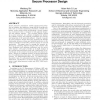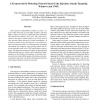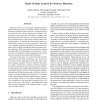112 search results - page 12 / 23 » Securely Obfuscating Re-encryption |
ACSAC
2010
IEEE
13 years 6 months ago
2010
IEEE
The JavaScript language is a core component of active and dynamic web content in the Internet today. Besides its great success in enhancing web applications, however, JavaScript p...
MICRO
2006
IEEE
14 years 2 months ago
2006
IEEE
Secure processor architecture enables tamper-proof protection on software that addresses many difficult security problems such as reverse-engineering prevention, trusted computing...
SP
2009
IEEE
14 years 3 months ago
2009
IEEE
Malware authors have recently begun using emulation technology to obfuscate their code. They convert native malware binaries into bytecode programs written in a randomly generated...
ACSAC
2005
IEEE
14 years 2 months ago
2005
IEEE
Code injection vulnerabilities continue to prevail. Attacks of this kind such as stack buffer overflows and heap buffer overflows account for roughly half of the vulnerabilities...
ACSAC
2007
IEEE
14 years 2 months ago
2007
IEEE
Malicious code is an increasingly important problem that threatens the security of computer systems. The traditional line of defense against malware is composed of malware detecto...



